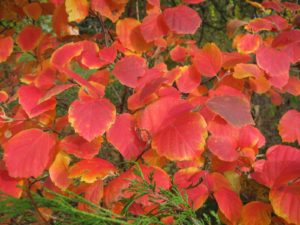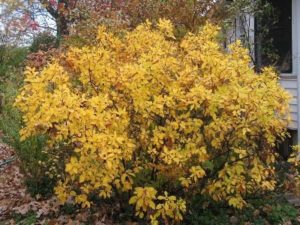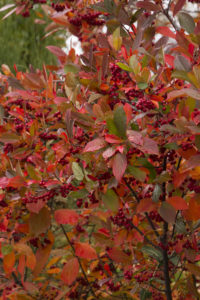Rather than consider fall a farewell to another growing season, we should celebrate its unparalleled brilliance from foliage, berries, bark and stems. Certain native flowering shrubs not only offer a pollinator friendly flowers, they can also provide dazzling leaves for an outstanding last hurrah. Below are a few nice choices hardy in Zones 5 or colder.
 Fothergilla major Commonly called Bottlebrush, this member of the witch-hazel family has pretty creamy-white, fragrant flowers in spring. But it’s the red, yellow and orange fall foliage that really draws the ahhs. Heights range 3’ -8’ Sun – Part Sun. Zones 4-8 (pictured)
Fothergilla major Commonly called Bottlebrush, this member of the witch-hazel family has pretty creamy-white, fragrant flowers in spring. But it’s the red, yellow and orange fall foliage that really draws the ahhs. Heights range 3’ -8’ Sun – Part Sun. Zones 4-8 (pictured)
Azalea viscosum Swamp Azalea is the last Azalea to burst into bloom. Highly fragrant white or pink flowers open in June and continue into July. Hummingbirds and butterflies enjoy the flowers. Unlike many Azalea, it tolerates wet soil. Swamp Azalea turns a striking red, orange and purple in fall. 5’-8’ Part Sun – Part Shade. Zones 4 – 9.
Clethra alnifolia Summersweet is named for its heavenly fragrance in late July and August. White or 
Rhus aromatica ‘Gro-Low’ Sumac is a groundcover shrub (18”-24” tall) with shiny, dark green leaves that turn bright burgundy-red in fall. Yellow-green pendant flowers in spring are followed by red fruit. ‘Gro-Low’ is a fantastic problem-solver for slopes and banks with poor, dry soil. Sun-Part Sun. Zones 4-9.
Vaccinium corymbosum Highbush Blueberry provides three seasons of interest between white spring flowers, yummy summer berries, and stunning red foliage in fall. Cultivar heights range from 4’-12’. Full to Part Sun. Zones 3 – 8
Aronia arbutifolia ‘Brilliantissima’ Red Chokeberry is another spring through fall beauty. Small white flowers in May produce ¼” red berries 
Viburnum nudum ‘Winterthur’ This popular Viburnum has it all – fragrant white flowers in spring; pinkish-red berries that turn blue and mature to purplish-black; and striking, red-purple leaves in fall. ‘Winterthur’ is more compact than the straight species. It grows to 6’. Sun – Part Shade. Zones 5 – 9. This is just one of numerous native Viburnum that make great specimens.
Itea virginica The riveting red fall foliage of Virginia Sweetspire will stop you in your tracks. It is a terrific alternative to Burning Bush, which is invasive in many states. Cultivars range in height from 2’-5’ with white drooping flowers in early summer. Butterflies and other pollinators love the flowers, songbirds feast on its seeds. Sun – Part Shade. Hardy in Zones 5-9
